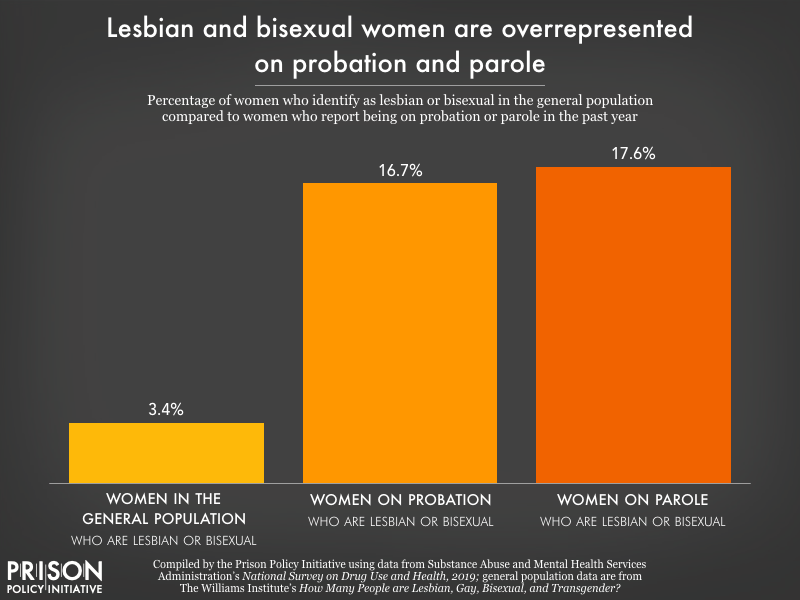Editor’s Note: That’s right, we’re taking a look back (you know, hindsight) to see how we can best prepare (that’s the foresight; I think you get the idea) for the future, and in order to do that, we worked with professor Betsy Weiss (Communications professor at Tulane University) and her students to investigate the prison system and what we can and should be learning from its past and present.

Lesbian and bisexual women have one of the highest prison incarceration rates. Lesbian and bisexual women, as seen in the graphs above, have a greater rate of arrest than the rest of the jail population. Unlike in the female prison system, sex is a source of violence in the male jail system, where it is used to emulate authority among other inmates. The female jail system is based on their feelings. According to ABC News, it states “Unlike, in male prisons where sex is used as a tool of violence and intimidation, inmates and guards say the sex in female prisons tends not to be coercive. Instead, a lot of the violence in Metro is about jealousy or possessiveness.”
So let’s get into some facts: lesbians and bisexuals are more likely than straight women to be placed on probation according to prisonpolicy.org (6.3 percent ). Women on parole are nearly three times as likely as women who are not on parole to be homosexual or bisexual (17.6%). Women on probation are nearly three times as likely to be lesbian or bisexual (16.7%) as women not on probation (6.3%). Lesbian and bisexual women behave differently than other convicts, and they are more likely to be incarcerated than straight women. They are also more likely to be eligible for probation or parole than straight women.
Gay and bisexual men experience prejudice because of their gender identity and masculinity. Many males in the prison system use homophobia to demonstrate their power. According to The Conversation conclusion, writers emphasize that “The single-sex environment of prisons creates especially constricted views of gender roles, with a culture of hyper-masculinity dominating male prisons. Hierarchies of masculinity are often enforced through violence. In such an environment, any difference is seen as a weakness. Homophobia and transphobia are common. In their most extreme forms, this can include intimidation and physical and sexual violence. As one of the prisoners we interviewed said: People in here will prey on your weakness, they will prey on you. If you’re gay or bisexual, they’ll use that. They think that you are, as they say…a poof, and you can’t handle yourself. And they try to prey on you.”

Many people will argue that heterosexual individuals have it easier compared to people engaged in the lgbtq+ community. As introduced by The Williams Institute’s research team, it stated, “…LGB individuals receive longer sentences than heterosexual individuals, with lesbian or bisexual women and gay or bisexual men 4.6 and 2.7 times more likely than heterosexual women and men to receive prison terms exceeding 20 years, respectively. Additionally, sexual minorities were more likely to have spent time in disciplinary or administrative segregation or solitary confinement while incarcerated—26.8 percent of gay and bisexual men as compared with 18.2 percent of straight men and 37.2 percent of lesbians and bisexual women as compared with 12.7 percent of straight women experienced solitary confinement while incarcerated. And compared with straight inmates, sexual minorities are more likely to be sexually victimized while incarcerated—17.5 percent of gay and bisexual men and 13.1 percent of lesbians and bisexual women have been sexually assaulted by another inmate or staff as compared with 2.6 percent and 5.7 percent of straight men and women, respectively.”
The lgbtq+ community is affected by hate crimes, prejudice, and predation, all of which are linked to the prison system. In the United States, lesbian, gay, bisexual, and transgender (LGBTQ+) community prisoners endure a disproportionately high rate of sexual violence and receive little or no protection from the system. As a form of dominance, other convicts use rape, beatings, and picking on one another. We hope that by reading this article, readers can gain a better understanding of the lesbian, gay, bisexual, transgender, and queer (LGBTQ+) community. Please watch the movie below for a visual portrayal of the daily struggles that the lgtbq+ community faces in prison.
This piece is part of an on-going series produced in Professor Betsy Weiss’s class, “Punishment and Redemption in the Prison Industrial Complex,” which is taught at Tulane University.
 NOLAbeings Multimedia artist Claire Bangser created NOLAbeings as a portrait-based story project that marries...
NOLAbeings Multimedia artist Claire Bangser created NOLAbeings as a portrait-based story project that marries...  Voodoo in New Orleans: Reviving history: New Orleans fortune telling This article takes a deep dive into the history of Voodoo in New Orleans, its hybridization with Catholicism, and its present-day place in the city's culture. The author visits fortune-tellers in the French Quarter, using their guidance as a tool for introspection rather than a deterministic predictor of the future. Through her experiences in New Orleans, the author feels a mystical connection to both the past and the future.
Voodoo in New Orleans: Reviving history: New Orleans fortune telling This article takes a deep dive into the history of Voodoo in New Orleans, its hybridization with Catholicism, and its present-day place in the city's culture. The author visits fortune-tellers in the French Quarter, using their guidance as a tool for introspection rather than a deterministic predictor of the future. Through her experiences in New Orleans, the author feels a mystical connection to both the past and the future. 